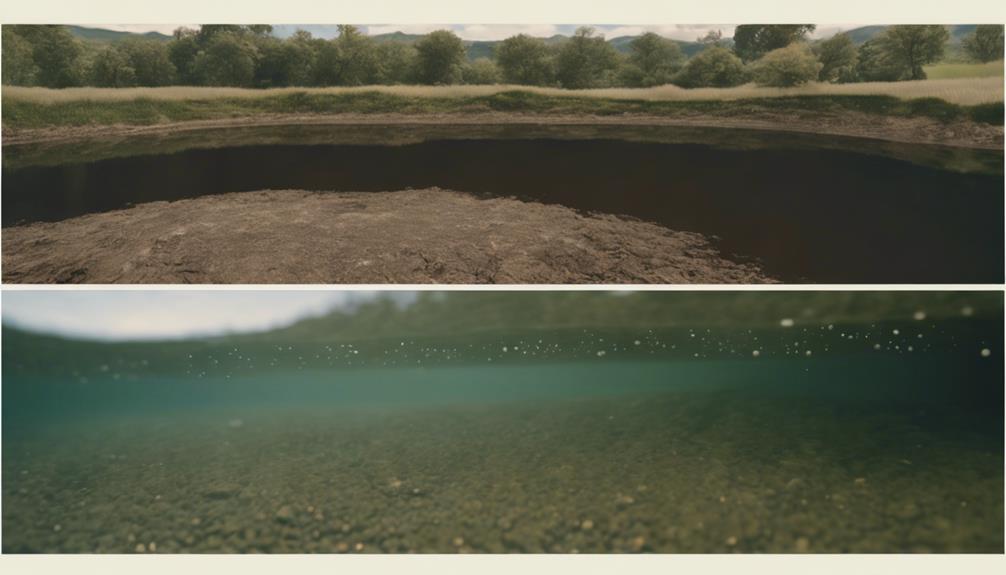By incorporating an aeration system, you can improve water quality naturally, increasing oxygen levels to support aquatic life and reducing anaerobic zones. You'll also prevent algae blooms, eliminate unpleasant odors and tastes, and enhance fish health and well-being. Additionally, aeration systems reduce sediment and sludge buildup, control mosquitoes and pests, and promote balanced ecosystems and habitats. In addition, they increase water clarity and visibility, making your waterbody more aesthetically pleasing. As you explore the benefits of aeration systems, you'll discover the full potential of this innovative technology to transform your water's health and beauty.
Table of Contents
Key Takeaways
- Aeration systems improve water quality by increasing oxygen levels, reducing anaerobic zones, and enhancing aesthetic appeal.
- Adequate oxygenation supports the growth of beneficial aquatic plants, providing habitat and food for aquatic organisms.
- Aeration prevents excess nutrient buildup, inhibits algae spore germination, and reduces water clarity issues, thereby controlling algae growth.
- Regular aeration maintenance eliminates unpleasant odors and tastes by removing impurities, increasing oxygen levels, and breaking down organic matter.
- Aeration creates a balanced ecosystem, supporting a diverse range of aquatic life, and reduces fish mortality rates by increasing dissolved oxygen levels and improving immune function.
Improving Water Quality Naturally
By incorporating an aeration system into your water management strategy, you can substantially reduce the levels of dissolved gases, sediments, and other impurities that degrade water quality.
This is because aeration introduces oxygen into the water, enhancing its quality and promoting a healthier aquatic environment.
As oxygen levels increase, the ability of water to hold dissolved gases and sediments decreases, resulting in a significant improvement in water quality.
A well-designed aeration system can improve water quality by increasing oxygen levels, reducing the formation of anaerobic zones, and enhancing the overall aesthetic appeal of the water body.
By improving water quality, you can create a more hospitable environment for aquatic life to thrive.
Additionally, aeration can help prevent the growth of algae, reduce unpleasant odors, and eliminate unsightly surface scum.
Increased Oxygen for Aquatic Life
You can substantially enhance the health and well-being of aquatic life by maintaining adequate dissolved oxygen levels, which is only possible with an effective aeration system. Inadequate oxygen levels can lead to stress, disease, and even death in fish and other aquatic organisms. Aeration systems increase dissolved oxygen levels, which is essential for the survival of aquatic life.
| Benefits of Aeration | Effects on Aquatic Life |
|---|---|
| Increases oxygen levels by up to 2-3 ppm | Supports growth of beneficial aquatic plants |
| Maintains stable oxygen level | Reduces risk of fish kills |
| Increases oxygen directly | Enhances health and well-being of aquatic life |
In ponds, low dissolved oxygen levels can be detrimental to fish and other aquatic organisms. By increasing oxygen levels, aeration can support the growth of beneficial aquatic plants, which provide habitat and food for aquatic organisms. Additionally, a well-designed aeration system can also help to reduce the risk of fish kills by maintaining a stable oxygen level, even during periods of high water temperature or low water flow. With adequate oxygen, you can create a thriving aquatic ecosystem, where fish and other aquatic organisms can flourish.
Reducing Algae Blooms and Growth

When you implement an aeration system, you'll prevent excess nutrient buildup, inhibit algae spore germination, and reduce water clarity issues.
By addressing these key factors, you'll create an environment that's less conducive to algae blooms and growth.
As a result, you'll be able to maintain a healthier, more balanced ecosystem.
Prevent Excess Nutrient Buildup
Excess nutrient buildup in your pond or lake can lead to devastating consequences, including the formation of algae blooms that deplete oxygen levels and create toxic environments for aquatic life. As a responsible waterbody owner, it's crucial to prevent excess nutrient buildup to maintain a healthy ecosystem. Aeration systems can play a vital role in achieving this goal.
| Nutrient | Effect on Waterbody | Aeration System Benefit |
|---|---|---|
| Nitrogen | Excessive growth of algae and aquatic plants | Reduces nitrogen levels, preventing eutrophication |
| Phosphorus | Fosters algae blooms, depleting oxygen levels | Removes phosphorus, inhibiting algae growth |
| Carbon | Increases water acidity, harming aquatic life | Helps maintain a stable pH, reducing acidity |
| Oxygen | Essential for aquatic life, depleted by algae blooms | Increases oxygen levels, supporting aquatic life |
Inhibit Algae Spore Germination
By disrupting calm water conditions, aeration systems effectively inhibit algae spore germination, thereby reducing the likelihood of excessive algae blooms and growth.
As you consider implementing a lake aeration or pond aeration system, you'll be creating an environment that's less conducive to algae growth. By adding oxygen to the water, you'll reduce the formation of harmful algal blooms.
Additionally, aeration facilitates the conversion of phosphorus to forms unusable by algae, further limiting their growth potential. The increased water circulation and mixing caused by aeration systems can prevent the formation of 'dead zones' where algae can thrive, reducing the overall algae population.
By inhibiting algae spore germination, you'll also reduce the risk of toxin-producing algae, which can harm aquatic life and human health.
Reduce Water Clarity Issues
As you implement an aeration system, you'll notice a significant reduction in water clarity issues, primarily due to the suppression of algae blooms and growth.
This is because aeration increases oxygen levels throughout the water column, from the surface to the bottom. With more oxygen, the sediment layer at the bottom of the water body is better able to break down organic matter, reducing the nutrient availability that fuels algae growth.
Moreover, aeration helps to circulate the water, preventing stagnant areas where algae can thrive. As oxygen-rich water is circulated to the surface, it reduces the likelihood of algae blooms forming.
This, in turn, improves water clarity, making it more aesthetically pleasing and conducive to aquatic life. By reducing algae growth, you'll also notice a decrease in the murky, greenish hue that often accompanies excessive algae populations.
Instead, your water body will be characterized by clear, healthy water with a balanced ecosystem. With an aeration system, you can enjoy the benefits of improved water clarity, creating a more inviting and sustainable environment for you and your aquatic community.
Eliminating Unpleasant Odors and Taste
When you install an aeration system, you can say goodbye to the foul odors and unpleasant tastes that often plague stagnant water. By increasing oxygen levels and improving water circulation, aeration systems can eliminate the conditions that lead to the formation of hydrogen sulfide gas, a primary contributor to unpleasant smells in water.
Aeration systems can improve the taste and odor of your water in several ways:
Reduced hydrogen sulfide: Aeration disrupts the conditions that lead to the formation of hydrogen sulfide gas, eliminating foul odors.
Increased oxygen levels: Aerating water removes impurities and increases oxygen levels, eliminating the musty or earthy taste often associated with stagnant water.
Reduced algae growth: Proper aeration reduces the growth of algae, which can produce compounds that give water an unpleasant taste or odor.
Broken down organic matter: Aeration breaks down organic matter that contributes to unpleasant odors and tastes, resulting in fresher, cleaner-tasting water.
Enhancing Fish Health and Well-being

When you install an aeration system, you're taking a vital step towards enhancing fish health and well-being.
By increasing dissolved oxygen levels and improving water quality, you're creating an environment that reduces stress levels and supports improved immune function in your fish.
This, in turn, enables them to thrive and reach their full potential.
Reduced Stress Levels
By maintaining a stable and healthy environment, aeration systems play a key role in reducing stress levels in fish, which is essential for their well-being and survival.
As an aquarist, you know that high stress levels can lead to fish kills and poor water quality. Aeration systems help to mitigate this by increasing dissolved oxygen levels, which are necessary for the survival of fish.
In fact, studies have shown that aerated ponds have a significant reduction in fish mortality rates compared to non-aerated ponds.
Four key ways aeration systems reduce stress levels in fish:
- Increased oxygen distribution: Aeration systems facilitate that oxygen is evenly distributed throughout the water, reducing the risk of oxygen depletion.
- Reduced water temperature fluctuations: Aeration systems help to regulate water temperature, preventing sudden changes that can cause stress in fish.
- Improved water quality: By reducing ammonia and other toxic substances, aeration systems create a healthy aquatic environment that minimizes stress in fish.
- Prevention of sudden changes: Aeration systems help to prevent sudden changes in water chemistry, which can be detrimental to fish health.
Improved Immune Function
An aeration system's ability to maintain ideal water quality and oxygen levels directly enhances your fish's immune function, allowing them to fight off diseases and parasites more effectively.
When you increase dissolved oxygen levels, you're creating an environment that supports beneficial bacteria growth. These bacteria play a vital role in breaking down organic matter, which in turn reduces the risk of disease-causing pathogens.
With oxygen throughout the water column, your fish can thrive, and their immune system can function at its best. Aeration supports this process by promoting the breakdown of organic matter, which would otherwise consume oxygen and create toxic byproducts.
By maintaining higher oxygen levels, you're giving your fish the best chance to develop a strong immune system. This means they'll be better equipped to handle stress, resist disease, and recover quickly from illness.
Supporting Beneficial Bacteria Growth
Increasing oxygen levels through aeration supports the growth of beneficial bacteria, which are essential for maintaining a healthy balance of microorganisms in your waterbody. By providing an oxygen-rich environment, aeration systems enable beneficial bacteria to thrive, leading to improved water quality and reduced pollutant levels.
Enhanced metabolic processes: Aeration increases oxygen levels, which boosts beneficial bacteria's ability to break down organic matter and convert ammonia into nitrate.
Reduced algae growth: By promoting beneficial bacteria growth, aeration systems can reduce the need for algaecides and herbicides, as these microorganisms help prevent excessive algae growth.
Improved nitrogen cycle: Aeration enhances beneficial bacteria's ability to convert ammonia into nitrate, a less harmful compound for aquatic ecosystems.
Increased population: Aeration can increase the population of beneficial bacteria by up to 30%, leading to a significant reduction in ammonia and nitrite levels, which are toxic to aquatic life.
Reducing Sediment and Sludge Buildup

When you implement an aeration system, you'll notice a significant reduction in sediment and sludge buildup.
This is because aeration accelerates the sediment breakdown process, allowing for more efficient sludge reduction methods.
As a result, you'll enjoy a clearer water basin with reduced maintenance needs.
Sediment Breakdown Process
By incorporating an aeration system, you can effectively stimulate the sediment breakdown process, which is essential for reducing sediment and sludge buildup. This process is critical for maintaining healthy water quality and preventing the accumulation of bottom sediment. Through aeration, oxygen levels are increased, supporting the growth of beneficial microorganisms that decompose organic matter. This, in turn, reduces the buildup of sediment and sludge.
Breakdown of organic pollutants: Aeration stimulates the natural process of sediment oxidation, breaking down organic pollutants and reducing their accumulation.
Increased oxygen penetration: Aeration-induced circulation of water helps to redistribute sediment and sludge, allowing oxygen to penetrate deeper into the sediment layer, promoting further breakdown.
Reduced anoxic conditions: By introducing oxygen into the sediment layer, aeration reduces the risk of anoxic conditions that can lead to the release of nutrients and other pollutants.
Improved water quality: By reducing sediment and sludge buildup, aeration systems can decrease the likelihood of nutrient release from sediments, contributing to healthier water quality and a more balanced ecosystem.
Sludge Reduction Methods
Implementing a well-designed aeration system is key to reducing sediment and sludge buildup, as it targets the root causes of these issues and creates an environment that inhibits their accumulation.
By increasing oxygen levels, you promote the growth of beneficial bacteria that break down organic matter, resulting in a 30-50% reduction in sludge accumulation.
Proper aeration also decreases the thickness of sediment layers by up to 50%, making it easier to maintain water quality and reducing the need for dredging.
Additionally, aeration reduces the accumulation of volatile solids, a primary contributor to sludge buildup, by up to 70%, leading to a significant decrease in maintenance costs.
In addition, by increasing water circulation and mixing, aeration systems can reduce the settling of suspended solids, which can contribute to sludge buildup, by up to 90%.
Regular aeration prevents the formation of anaerobic zones, which can lead to the production of hydrogen sulfide and methane gases, thereby exacerbating sludge buildup and water quality issues.
Clearer Water Basin
Your water basin will remain clearer for longer periods with an effective aeration system, which dramatically reduces sediment and sludge buildup by fostering a healthy aquatic environment. This is because aeration increases oxygen levels in the water column, promoting the growth of beneficial algae that help break down organic matter. As a result, you'll notice a significant decrease in sediment and sludge accumulation.
Enhanced oxygenation: Aeration introduces oxygen into the water, which is essential for aerobic decomposition of organic matter.
Increased water circulation: Aeration systems promote water movement, preventing stagnation and reducing the formation of anaerobic zones.
Reduced algae blooms: By controlling algae growth, aeration prevents excessive nutrient uptake, which can lead to water quality issues.
Improved sediment breakdown: Aeration stimulates the growth of microorganisms that break down sediments, resulting in a clearer water basin.
With a well-designed aeration system, you can enjoy a healthier, clearer water basin that requires less maintenance and supports a thriving aquatic ecosystem.
Mosquito and Pest Control Methods
Effective mosquito and pest control methods, including aeration systems, can substantially reduce the presence of these nuisance organisms in your waterbody.
You can take a proactive approach to maintaining your ponds or lakes by incorporating aeration systems into your maintenance routine. Aeration increases oxygen levels in the water, which in turn improves water quality by reducing algae growth.
With reduced algae, your waterbody becomes less appealing to mosquitoes and pests. Additionally, aeration helps to circulate water, preventing stagnation and creating an environment that's unfavorable to pest breeding.
As an aquatic ecosystem owner, you understand the importance of maintaining a balanced environment.
By investing in aeration systems, you're not only reducing pest populations but also promoting a healthier ecosystem. Regular aeration maintenance guarantees that your waterbody remains clean, clear, and pest-free.
This, in turn, creates a more enjoyable experience for you and your community. By taking control of mosquito and pest populations, you're contributing to a safer, more pleasant environment for everyone.
Promoting Balanced Ecosystems and Habitats

By maintaining a balanced ecosystem, you can create a thriving habitat that supports a diverse range of aquatic life, and aeration systems play a vital role in achieving this delicate balance.
Aeration enhances fish habitat by disrupting thermal stratification and increasing oxygen levels, leading to a significant improvement in fish health and survival rates.
Additionally, aeration systems promote a balanced ecosystem by reducing the likelihood of excessive algae growth, which can deplete dissolved oxygen and lead to fish kills.
Increased oxygen levels: Aeration systems increase dissolved oxygen, supporting a diverse range of aquatic life.
Reduced algae growth: By reducing algae growth, aeration systems prevent the depletion of dissolved oxygen and maintain water quality.
Improved water circulation: Aeration systems increase water circulation and mixing, distributing nutrients and oxygen evenly throughout the waterbody.
Healthy ecosystem maintenance: Aeration systems facilitate the decomposition of organic matter, reducing sediment accumulation and maintaining a healthy ecosystem.
Increasing Water Clarity and Visibility
As you consider implementing an aeration system, you'll want to know how it can improve your water's clarity and visibility.
Aeration systems consistently improve water clarity and visibility by increasing the settling of suspended particles and sediment. This is because aeration increases oxygen levels in the water, which in turn enhances water movement and circulation.
As a result, sediments and particles settle to the bottom, allowing you to enjoy clearer water. Additionally, aeration systems help reduce algae growth, a common culprit behind cloudy water.
By introducing more oxygen into the water, you'll create an environment that's less conducive to algae blooms. Surface aerators, in particular, are effective at increasing water movement and circulation, further improving water clarity.
With an aeration system, you can expect significant improvements in water quality, making it perfect for recreational activities or simply enjoying the aesthetic appeal of clear water.
Frequently Asked Questions
Does Aeration Improve Water Quality?
You'll notice a significant improvement in water quality when you increase oxygen levels, as it boosts water clarity, supports aquatic life, reduces algae growth, optimizes nutrient cycling, and minimizes sediment reduction, all while maintaining a healthy pH balance and improving water circulation.
How Does Aeration Help Purify Water?
As you gaze into the calm water, imagine a silent warrior, oxygen, battling the darkness of bacteria growth. Aeration helps purify water by boosting oxygen levels, sparking chemical reactions, and enhancing filtration efficiency, sediment removal, nutrient cycling, and microbial activity, ultimately revealing crystal-clear water that invites you to take a rejuvenating dip.
How Does Aeration Affect the Water?
As you introduce aeration, you'll notice it boosts oxygen levels, clarifies the water, and reduces temperature fluctuations, thereby controlling bacterial growth, distributing sediment, altering current patterns, and regulating pH balance and nutrient cycling.
Why Does Water Need to Be Aerated?
Did you know that 70% of the world's oxygen comes from aquatic plants? You need to aerate water because it boosts oxygen levels, improving water clarity and circulation, which supports aquatic life, regulates nutrient uptake, maintains pH balance, and aids sediment removal, all while controlling bacterial growth.
Conclusion
An aeration system is the unsung hero of water quality management, akin to a medieval knight defending the kingdom against the dark forces of stagnation.
By harnessing the power of oxygen, you'll tap a cascade of benefits that'll leave your water sparkling like a diamond in the sun.
From boosting aquatic life to banishing unpleasant odors, the advantages are undeniable.
So, take the plunge and breathe new life into your water – the future of your ecosystem depends on it.

